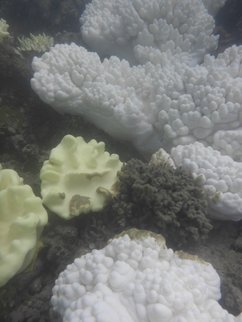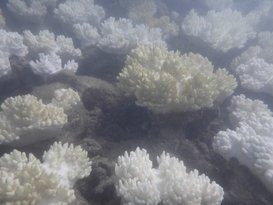 I had the pleasure of hearing Professor Terry Hughes present as part of the Sydney Ideas talks being run by the University of Sydney. Professor Hughes is Centre Director at the ARC Centre for Excellence for Coral Reef Studies at James Cook University. I use the term "pleasure" because I am a big fan of his work, and think that some of the visual representations that he has created have been incredibly powerful in explaining coral bleaching to students, but actually the information presented was really quite depressing. Image left: Photograph of bleached corals at Fitzroy Island April 2017. Hughes described some of the main drivers of degradation of coral reefs: pollution, overfishing and climate change. He explained how overfishing had resulted in the reduction of stock sizes for different species in the past century, how pollution from inland activities resulted in coral mortalities and encroachment of different ecosystems like mudflats in areas previously thriving with corals. He went on to say that the scale and extent of these changes were being dwarfed by the immediate and irreparable changes being wrought by back to back bleaching events. Below right: Bleached coral on Fitzroy Island April 2017. Mass bleaching events have occurred in both 2016 and 2017 as a result of increased ocean temperatures. The bleaching is as a result of corals expelling their symbiotic algae. Coral bleaching tends to occur after the summer temperature maximum, and relates to where the hottest water is. In 2016 coral bleaching severely bleached the northern third of the Great Barrier Reef, the middle section was bleached to a lesser extent, but still quite severely, while the bottom third of the reef largely escaped bleaching in 2016. This was established by the surveying of 1160 reefs through 9000km of aerial surveys, and 75 hours of flying. The 2017 bleaching event impacted the central section of the GBR, while the bottom third is again largely unbleached. Cycle Debbie, a chance weather event, lowered temperatures in the southern part of the reef, which contributed to reducing bleaching in this section. The combination of both the 2016 and 2017 bleaching events has been extremely damaging. There have been reports that the recent cyclone that affected Queensland, Cyclone Debbie may play a role in reducing the impact of coral bleaching. It was reported in the Cairns Post that the cyclone would reduce ocean temperatures, bring cooler waters to the surface and increase cloud cover, thus reducing bleaching, providing stressed corals with an opportunity to recover. The Cairns Post reported that temperatures off Lizard Island had dropped by three degrees and that this would reduce the severity of bleaching. It also provided quotes from a free diver describing the amazing colours and marine life of the outer reef. In reality, as already stated Lizard Island and the top third of the Great Barrier Reef were already severely affected by bleaching in 2016 (well before Cyclone Debbie) and were again affected in 2017. In any case, the path of the cyclone was too far south to have any real impact on areas severely affected by bleaching. Will the Great Barrier Reef recover? There is a narrow opportunity for limited recovery, but the Great Barrier Reef as we know it (complexity, extent, etc) is already dead in many areas. It will continue to exist but with reduced biodiversity. Any real opportunities to protect the reef as it remains is reliant on halting temperature increases and stabilising the climate through reducing reliance on fossil fuels. With negotiations underway between the Australian Government and Adani for for the creation of the Marmichael mines this seems highly unlikely. For more detail on coral bleaching see my article in this term's GTA NSW HSC edition of the Bulletin. http://www.gtansw.org.au
0 Comments
Your comment will be posted after it is approved.
Leave a Reply. |
Categories
All
Archives
December 2023
|

